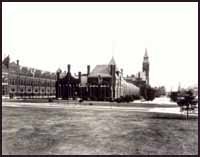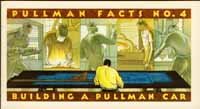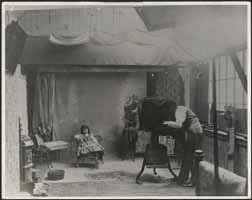The Arctic Explorer
You are at Home -> The Pullman Company -> The Arctic ExplorerThe Second Polar Expedition
Admiral Richard Evelyn Byrd conducted 5 polar expeditions to the Antarctic between 1928 and 1956. On his second expedition in 1934, Byrd spent five winter months alone operating a meteorological station, Advance Base, from which he narrowly escaped with his life after suffering carbon monoxide poisoning from a poorly-ventilated stove. Unusual radio transmissions from Byrd finally began to alarm the men at the base camp, who then attempted to go to Advance Base. The first two trips were failures due to darkness, snow, and mechanical troubles. Finally, Dr. Thomas Poulter, E.J. Demas, and Amory Waite arrived at the base where they found Byrd in poor physical health. The men remained at the base until October 12, when an airplane from the base camp picked up Dr. Poulter and Byrd. The rest of the men returned to base camp with the tractor.Dr. Thomas C. Poulter
After covering hundreds of miles in small tractors under emergency conditions, Poulter knew how cramped and impractical they were for long hauls. Poulter convinced his colleagues that future polar explorations required a purpose-built vehicle, impervious to the extreme conditions and able to act as a mobile base of exploration. When the United States government announced plans for a 3rd Antarctic expedition in 1939, Poulter and his colleagues presented plans for an enormous "snow cruiser" that the press immediately dubbed the Penguin. The vehicle was to be built (at the cost of some $150,000) and lent to the government. The U.S. was very interested in the Antarctic for strategic reasons: the Germans had claimed a part of Antarctica as New Swabia and were considering building a U-Boat base there to menace shipping coming around the cape of Africa. When he got final approval for his plans, Poulter had less than 6 months to complete a revolutionary new vehicle with a range of 5,000 miles that could carry a crew of 5 and supplies for a year AND function in the extreme conditions of Earth's harshest environment. Despite the tight time schedule and design challenges, Poulter persuaded over 70 companies to donate lab space, materials, and equipment to the project. The Pullman Company built the vehicle.Carlson Images
In 2002, former Pullman employee Martin Carlson donated a set of original Pullman Company builders' photographs of the Snow Cruiser.

|

|

|

|

|

|

|

|

|

|

|

|

|

|

|

|

|

|

|

|

|

|
Construction
Construction began on August 8, 1939. The vehicle had to be built by November, when the expedition's ships would sail from the Boston Naval Yard. The completed vehicle was 55 feet 8 inches long, 19 fee t 10.5 inches wide, and 16 feet high. Fully loaded it weighed 75,000 pounds. Power was supplied by diesel engines, which drove generators that ran electric motors in the wheel hubs. The vehicle had a machine shop, a darkroom/kitchen, and living quarters. In the rear was storage space for fuel, food, and tires. The antifreeze that cooled the engines was circulated through radiators to heat the living quarters.
The completed vehicle undergoing tests. |

Tests were conducted in the Indiana Dunes area. |
The Journey to Boston
The crew made the journey from Chicago to Boston, accompanied by a number of police and press vehicles.
|

En route to Boston. |

|

Chicago Tribune, Oct. 29, 1939, p. 6. |

Christian Science Monitor, Nov. 9, 1939, p. 9. |

The Framingham traffic jam, en route to Boston. New York Times, Aug. 13, 1934, p. 1 |
Voyage and Arrival
In early November, the cruiser arrived at Boston Naval Yard and boarded the remarkable polar exploration ship the U.S.S. North Star. The cruiser was too large to fit on deck, so the rear cargo container had to be cut off. On November 15, the North Star set sail for the Antarctic. The expedition included Admiral Byrd and Poulter, both of whom would leave the expedition shortly after its arrival and return to the United States to raise funds for the continued operations of the expedition. Once the ship reached Byrd's Little America base on the Ross Ice Shelf in early January 1940, the limitations of the cruiser rapidly became apparent. The weight of the cruiser caused it to almost crashed through the timber ramp when Poulter drove it off the ship.
Reattaching the cargo compartment. |

The Penguin with its namesake. |

The aircraft and the assembled antarctic cruiser. |

Causing crowds to gather, even on the Ross Ice Shelf. |

Lecture at the Field Museum of Natural History by Dr. Poulter about his adventures. |

Philatetic cover. |

Philatetic cover. |
Aftermath
The Polar Explorer never made it very far; it only travelled about 12 miles before it became hopelessly mired in the snow. It made a very good base camp, however, and the expedition used it as such to conduct explorations throughout the Antarctic summer of 1940. The expedition returned to the U.S. at the beginning of June, 1940. The U.S. Navy had other worries in 1940 and 1941, so the team never returned to the Explorer. The U.S.S. North Star and its sister ship, the Polar Star, were called into service when the U.S. entered World War II. They formed part of the escort for convoys bound for Murmansk. Dr. Poulter went on to join the Stanford Research Institute as director in 1948 where he lived an extraordinarily rich life and did important research in a variety of subjects. He was director until his death in 1978. The Antarctic Explorer was abandoned in place. It was rediscovered in 1958 during the International Geophysical Year by a team in Antarctica. Parts of the Ross Ice Shelf including the Little America base have since calved off, a victim of global warming, presumably taking the Penguin with it.THE PULLMAN HISTORY SITE

More Information About the Pullman Company
Products from the Factory
Edison Films of Pullman Travel

From A Romance of the Rail, 1903
Other Pullman-Related Sites
- Historic Pullman Garden Club - An all-volunteer group that are the current stewards of many of the public green spaces in Pullman. (http://www.hpgc.org/
- Historic Pullman Foundation - The HPF is a non-profit organization whose mission is to "facilitate the preservation and restoration of original structures within the Town of Pullman and to promote public awareness of the significance of Pullman as one of the nation's first planned industrial communities, now a designated City of Chicago, State of Illinois and National landmark district." (http://www.pullmanil.org/)
- The National A. Philip Randolph Pullman Porter Museum is a 501(c)3 cultural institution. Its purpose is to honor, preserving present and interpreting the legacy of A. Philip Randolph, Pullman Porters, the Brotherhood of Sleeping Car Porters and the contributions made by African-Americans to America's labor movement. ((http://www.nationalpullmanportermuseum.com/)
- Pullman Civic Organization - The PCO is a strong and vibrant Community Organization that has been in existence since 1960. (http://www.pullmancivic.org/)
- Pullman National Monument - The official page of the Pullman National Park. (https://www.nps.gov/pull/)
- South Suburban Genealogical & Historical Society - SSG&HS holds the Pullman Collection, consisting of personnel records from Pullman Car Works circa 1900-1949. There are approximately 200,000 individuals represented in the collection. (https://ssghs.org/)
- The Industrial Heritage Archives of Chicago's Calumet Region is an online museum of images that commemorates and celebrates the historic industries and workers of the region, made possible by a Library Services and Technology Act grant administered by the Illinois State Library. (http://www.pullman-museum.org/ihaccr/)
- Illinois Digital Archives (IDA) is a repository for the digital collections libraries and cultural institutions in the State of Illinois and the hosting service for the online images on this site. (http://www.idaillinois.org/)












